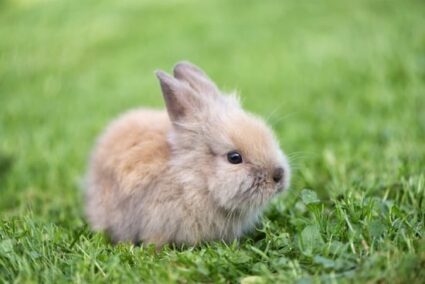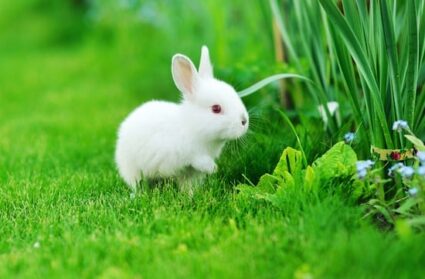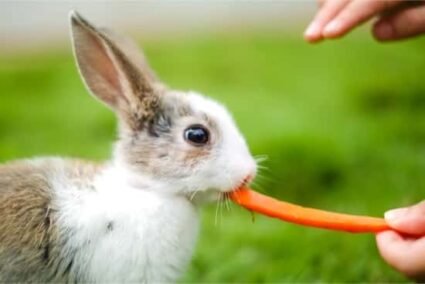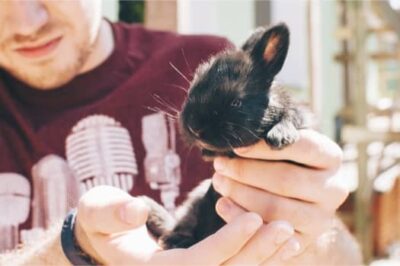Raising a litter of baby rabbits is a unique and rewarding experience. However, it’s important to learn how to take care of baby rabbits. Though the mother will do most of the work, there are things you need to know.
Set up a warm nest box for the babies to live in. Check the kits each day to make sure they are full and gaining weight. Once they reach 10 days old, provide them with alfalfa hay and pellets to nibble. They should be weaned and removed from their mother at 8 weeks old.
Rabbit mothers are good at looking after their young, but it’s up to you to make sure they’re healthy and well taken care of. We’ll explain what you need to know about looking after baby rabbits from birth to 8 weeks old.
How to Set Up a Nesting Box for Rabbits
Baby rabbits spend their first 2 weeks living exclusively inside their nest. They then begin to explore the outside world. Have the nest box ready for the baby rabbits ready at least 3 days before they are due. That way, the mother has time to prepare it to her liking. Here’s how:
- Select a large wooden box. A good size is 9 x 15 inches. The walls should be at least 5 inches high, to stop the babies from falling out.
- Line the bottom of the box with newspaper or paper pulp bedding. Add some soft eating hay, such as Timothy or Orchard.
- Make an indentation in the middle of the hay using your fist. This creates a space for the babies to be laid in. Then, give your rabbit a supply of hay to add her customization to it.
- Soon before your rabbit gives birth, she will start pulling out fur and adding it to the nesting box. This helps to keep the babies warm. Gather up any loose fur that you find and place it in the nest.
The mother rabbit should realize what the box is for and give birth to her babies inside it when the time comes. You should leave her alone while she gives birth, but check on the babies soon after.
When Can You Handle Baby Rabbits?
You may have heard that you should never touch a baby rabbit. Some people claim that the mother will refuse to feed her babies if she smells your scent, but this is untrue.
Domesticated rabbits are comfortable around humans. The mother won’t be alarmed by you handling the babies as she’s already used to you. Your scent won’t put her off caring for her young. As soon as the baby rabbits are born, it’s OK to handle them right away. You may even need to do so.
Your rabbit should give birth to all of her babies at once in the nesting box. These babies need to stay snuggled up together to regulate their body heat. However, rarely, rabbits can give birth to a baby outside of the box. It’s not known why this happens, but it’s potentially dangerous. The separated baby will quickly become cold and die.

Mother rabbits do not retrieve or move their young. If you notice a baby on its own, you must pick it up and put it back in the box. As long as the sides of the box are high enough, they’ll stay put once they’re inside.
Once per day, take each baby out to weigh them and check their condition. If you can’t tell the babies apart, mark the inside of their ears with a washable marker.
Don’t handle the babies for longer than you need to. According to the Journal of Applied Animal Welfare Science, being picked up can cause stress because rabbits are a prey species.
What Do You Feed Baby Rabbits?
Newborn rabbit kits need their mother’s milk. This will be their only nutrient source for the first 2 weeks of their life.
Don’t worry if you don’t see the doe spending time with her babies. Because rabbit milk is so calorific, baby buns only need to be fed twice per day. It’s normal for their mother to stay away from the nest most of the time.
The mother will usually feed her babies during the night, so you might never see the babies suckling. Fortunately, it’s easy to tell whether the babies are being fed.
Each morning, pick each baby up and examine their bellies. If they are being fed, their stomachs will look round, plump, and distended. They should also have lots of energy and be very wriggly. You should also weigh the babies each day. Their weights will vary, but they should each put on some weight every day.
Concave bellies, wrinkled bellies, and weight loss are all signs that the babies aren’t being fed properly. You should take the mother and all babies (in their nest box) to a rabbit veterinarian.
When To Feed Baby Rabbits Solid Food
Baby rabbits open their eyes when they’re about 10 days old. At this point, they’re ready to start eating solid food. Some kits may begin nibbling earlier than others, but they should all be eating solids after 2 weeks. A healthy diet for baby rabbits includes:
- Alfalfa hay. This is much higher in calories than grass hay.
- Pellets. These should be quality hay pellets with no added extras.
The babies should be allowed unlimited access to the above foods. You should also give them a shallow water dish, although they may not start drinking until 3-4 weeks.
Rabbits under 8 weeks old should not eat any fresh vegetables or leafy greens. Their digestive systems are still developing and can’t handle veggies yet. Alongside solid food, the kits will continue drinking their mother’s milk. You may also notice that they begin eating their mother’s cecotropes (soft fecal pellets). This is an essential food for baby rabbits as it helps them to develop healthy gut bacteria.
When the babies are 6 weeks old, the doe should start feeding them less often. At 8 weeks, they’re ready to be weaned and removed from their mother. They can survive purely on solid food from here on out.
Do Baby Rabbits Have Diseases?
If you’re wondering how to keep baby rabbits healthy, it’s quite straightforward. Just provide them with adequate warmth and check them every day to make sure they’re fed and happy.
Baby rabbits can suffer from illness and poor health, just as adult rabbits can. Unfortunately, developing an illness at a young age is often fatal.

The most common baby rabbit illness is diarrhea. It is usually brought on by an imbalance of microbes in the cecum (part of a rabbit’s intestine). The cecum is the area where hindgut fermentation takes place. It’s supposed to be filled with good bacteria, which help rabbits digest their food. However, sometimes, bad bacteria, such as E. coli, can find their way in.
Diarrhea can kill quickly. If harmful bacteria aren’t the cause, it may be parasitical. To keep your baby rabbits healthy, you must check up on them every day. Make sure that they are well-fed, have full bellies, and are warm and wriggling. Keep watch for the following:
- Diarrhea or loose stools
- Stools containing blood
- Lethargy
- A concave stomach due to the baby not feeding
If you spot any of the above, take your babies to the vet in their nest box. Your veterinarian will have to follow an emergency protocol to keep them alive, as outlined by the University of Miami.
How to Setup a Cage for a Baby Rabbit
Until the baby rabbits are 2 weeks old, they will live permanently in the nest box. Before this age, they’ll spend all their time nestled up together.
A few days after their eyes open, they’ll become quite curious. They’ll suddenly want to start exploring. Before this happens, you should ensure that you have rabbit-proofed the room that the nesting box is in.
Make sure all cords and cables are inaccessible. Put anything unsafe, or that you don’t want chewed, high up. Use a baby fence or playpen to cordon off troublesome areas.
Rabbits are happiest when they have access to a large space to run around in. If you can’t give them an entire room, the next best thing is a wire pen. It should have 32 square feet of space.
Commercially-sold cages are often too small for rabbits. If you do decide to use a cage, choose the biggest one that you can find. There should be a bare minimum of 12 square feet of space inside. The buns will still need access to a large pen for exercise during the day.
Inside the cage, pen or bunny room, provide a large litter box. It should contain paper-pulp litter, such as Carefresh, with hay on top. Include a few cardboard boxes and toys for the rabbits.
Make sure the buns have access to hay, pellets, and water at all times. The water dish should be shallow so the babies can’t drown. Here’s some advice on training a rabbit to use its tray.
When Can Rabbits Leave Their Mother?
Baby rabbits should be separated from their mother at 8 weeks old. The separation of a kit from its mother before 8 weeks can be risky. Baby rabbits need to develop healthy gut bacteria, and their mother’s milk and cecotropes help them to achieve this. Don’t give buns cows milk.
It’s common to see babies as young as 4 weeks old for sale in pet shops. However, being separated from their mother too early can be fatal. The babies’ guts can develop an imbalance of bacteria, resulting in death.
Once they reach 8 weeks of age, remove them from their mother straight away. Male rabbits can become sexually mature as young as 8-12 weeks old. They will mate with their mother if not separated from her.
Before finding new homes for your rabbits, take them for a checkup. The vet will assess their health, check for parasites, and sex the babies. Ideally, have any male babies neutered before you give them away. Females should not be spayed until they’re 4 months old.

Newborn Rabbit Care Without a Mother
Rabbits will usually do a great job caring for their young. As owners, we don’t need to intervene unless we feel the babies are being neglected. However, mothers can abandon their babies and refuse to feed them. Does can also die while giving birth, leaving live kits without a mother.
Raising healthy baby rabbits without a mother is possible. Orphaned babies struggle to thrive without their mother’s milk. They are prone to gut bacteria imbalances and ill health.
How to Keep Baby Rabbits Warm
- Set up a nesting box that is large enough to contain all the babies with room for them to grow in size.
- Line the bottom of the box with two thick, soft towels. Bunch one of them up slightly so that the babies have something to snuggle into.
- Place the babies inside with some soft nesting wool on top to mimic their mother’s fur. You can also use hay.
- Leave 1-2 inches of space above the kits so that they can breathe. Cover the box with a thin towel, leaving a small gap for airflow.
- Keep the room temperature between 68 and 72 degrees Fahrenheit. If it is any colder than 65 degrees, you’ll need to provide a heating pad on the lowest heat setting. Place it underneath towels on one side of the box. This allows the kits to move to a cooler area when too hot.
How To Hand Feed Baby Rabbits
There is no such thing as replacement rabbit milk formula. The closest thing available is replacement cat milk, designed for orphaned kittens.
The best brand is KMR (Kitten Milk Replacer). This comes in two forms: a powder that you make up with water and liquid milk in a can. For the best results, add two ingredients to the kitten milk:
- Acidophilus powder. This is a probiotic that helps orphaned rabbits form healthy gut flora. You can purchase it in capsule form. Break open the capsules and sprinkle a tiny pinch into each feeding.
- Heavy whipping cream with no sugar or other ingredients. Rabbit milk is higher in calories than kitten formula, so this helps them to put on weight. Add 1tbsp to 8oz of liquid milk.
Feed the kits twice per day, in the following amounts:
- 0-1 week old: 2-2.5cc per feed
- 1-2 weeks old: 5-8cc per feed
- 2-3 weeks old: 8-15cc per feed
- 3-8 weeks old: 15cc per feed
Use a syringe or eyedropper to feed the babies. Some kits like to drink lying on their backs, while others get on better upright. Feed them slowly and allow them to swallow naturally.
Starting at 2 weeks old, allow the kits unlimited access to alfalfa hay, grass hay, pellets, and water. You can also offer them cecotropes that are collected from an adult rabbit. This will help them to develop healthy gut bacteria.
At 7 weeks, start gradually decreasing the frequency of feeds. By 8 weeks, you can wean the kits off milk altogether.
How to Help a Baby Rabbit Poop
Newborn rabbits can’t go to the toilet by themselves. Their mother has to lick them after every feed in order to stimulate them to pee and poop. If your rabbit kits are orphaned, you have to mimic this process.
After each feed, moisten a cotton ball in warm water. Then, repeatedly stroke it over the kit’s anal and genital region. The kit should start to defecate and urinate. Its poop will be yellowish-green and soft. Continue stroking with the cotton ball until the kit has stopped going to the toilet.
As soon as the kits have opened their eyes, you can stop doing this. This should happen once they’re 10 days old.


My rabbit just had another litter her first litter is 4 weeks old she is taking all the fur out of the other babies body is it okay if I take those babies away from her because she’s hurting them
I am right now having that same problem. Did you ever happen to find an answer?